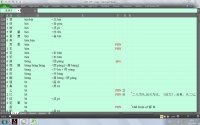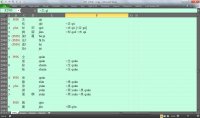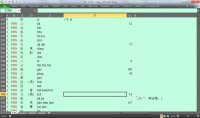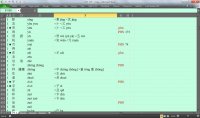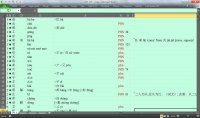Hi everybody,
In the attached zip file there are two Excel documents with a list of characters present in other characters as phonetic components. PHN refers to the ones that do not contain phonetic components in themselves (庚, 化, etc.); and "phn" to the rest, that's to say, characters that contain a phonetic component, and are themselves phonetic components (康, 华, etc.).
N.B.
These two lists are not meant for learning characters, but rather for keeping track of them, and getting visual exposure to its graphic structure.
< indicates a structural relationship, not a diachronic one.
† indicates that the preceding character has been included only for contrast.
[] indicates the phonetic component of the complex form
File DCF PY.xlsx (please, see attached image DCF PY.jpg)
Column A: HSK levels (0 = present in old HSK, absent in new)
Column B: simple form
Column C: complex form
Column D: pinyin
Column E: phonetic component
Column F: PHN/phn
Column G: radical
Column H-I: comments
File DCF PHN.xlsx (please, see attached image DCF PHN.jpg)
Column A: HSK levels (0 = present in old HSK, absent in new one)
Column B: PHN/phn
Column C: simple form
Column D: complex form
Column E: pinyin
Column F: phonetic component
Column G: PHN/phn
Column H-I: comments
.- The data can be sorted (please, see attached images DCF PY (sorted), DCF PHN (sorted).jpg)
.- An extra column may be added to keep track of the known characters (please, see attached images Keeping Track 1.jpg, Keeping Track 2.jpg)
Feedback welcome.
In the attached zip file there are two Excel documents with a list of characters present in other characters as phonetic components. PHN refers to the ones that do not contain phonetic components in themselves (庚, 化, etc.); and "phn" to the rest, that's to say, characters that contain a phonetic component, and are themselves phonetic components (康, 华, etc.).
N.B.
These two lists are not meant for learning characters, but rather for keeping track of them, and getting visual exposure to its graphic structure.
< indicates a structural relationship, not a diachronic one.
† indicates that the preceding character has been included only for contrast.
[] indicates the phonetic component of the complex form
File DCF PY.xlsx (please, see attached image DCF PY.jpg)
Column A: HSK levels (0 = present in old HSK, absent in new)
Column B: simple form
Column C: complex form
Column D: pinyin
Column E: phonetic component
Column F: PHN/phn
Column G: radical
Column H-I: comments
File DCF PHN.xlsx (please, see attached image DCF PHN.jpg)
Column A: HSK levels (0 = present in old HSK, absent in new one)
Column B: PHN/phn
Column C: simple form
Column D: complex form
Column E: pinyin
Column F: phonetic component
Column G: PHN/phn
Column H-I: comments
.- The data can be sorted (please, see attached images DCF PY (sorted), DCF PHN (sorted).jpg)
.- An extra column may be added to keep track of the known characters (please, see attached images Keeping Track 1.jpg, Keeping Track 2.jpg)
Feedback welcome.
Attachments
Last edited:

